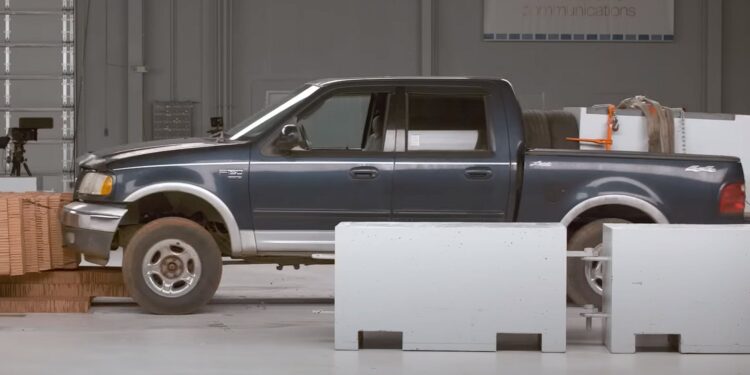Electric vehicles can get heavy. For example, the Rivian R1T pickup truck weighs over 7,100 pounds and the Hummer EV weighs over 9,000 pounds. Due to such hefty curb weights, the Insurance Institute for Highway Safety (IIHS) had to run tests to make sure its crash test rig could handle some of the heavier electric cars coming to market. To do so, they loaded pickup trucks with metal and concrete and rammed them into a wall.
The IIHS’s crash test rig pulls its test cars into the wall at 40 mph. Typically, the maximum weight of its test vehicles is between 5,000-6,000 pounds. According to Raul Arbelaez, VP of the IIHS’ vehicle research center, one of the heaviest vehicles the rig has ever tested was the Audi e-tron, which weighs over 6,000 pounds. However, with 9,000 pound-plus cars on the horizon, the IIHS needed to make sure its crash rig could get them up to speed.
So researchers at the IIHS took old, scrap pickup trucks and filled them up until they reached 9,500 pounds. And the test sled did it. It hurled the overweight trucks at the wall at 40 mph, proving that it can handle even the heaviest of upcoming EVs.
Why is this important? If the IIHS can’t properly test a vehicle’s crash rating on its own rig, then it wouldn’t be able to accurately judge its safety. The fact that it can handle such heavy vehicles is reassuring. Plus, it’s just fun to watch what happens to the truck when hits the wall. The giant vault-looking box in the bed slices through the cab of the truck like butter, ending up in the front seat, and the whole truck bends upward at each end, like a banana. What’s kind of terrifying, though, is the idea of what happens when a 9,000 pound SUV slams into a 2,900 pound Toyota Corolla. Sure, the passengers in the EV would likely be fine but I fear for the pour souls who have to be hit by something so heavy.
Got tips? Send ’em over to tips@thedrive.com


